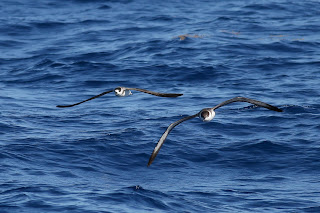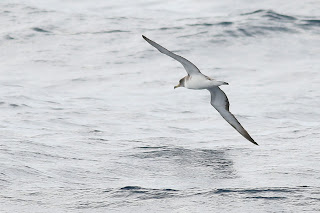Though we got a late start, May 27 vs. May 7, and only ran eight trips, instead of 20, we still managed to find 21 pelagic species this spring! Definitely an awesome run even losing two trips to weather! One of those weather days produced a White-winged Tern at Cape Point, though, spotted and identified by some of our participants (Ruben & Victor Stoll). Weather was interesting this spring and over the course of a couple weeks we had every wind direction imaginable. Some days it was choppy, some downright rough, and some quite pleasant! Easterlies were a big component here and to the south of us plus we had nice shots of north and south winds bringing us a nice variety of birds. Rain squalls were common, which also can make for some excellent birding! Following, I will cover each type of bird we saw, with notes about how many we had and on how many trips out of 8 they were encountered. The Spring 2020 Species Tally is here: https://patteson.com/wp-content/uploads/2020/11/Spring-2020.pdf and there are some photos at the end with labels, in order mentioned in the post! Thanks everyone for making these trips possible! Big thanks to Kyle Kittelberger, Ed Corey, Peter Flood, and Justin Bosler for all helping us lead the trips and contributing photos for our blog posts!
- Kate Sutherland
Gadfly Petrels
Black-capped Petrels were out there for every trip, as we always hope they will be! We found white-faced and dark-faced types plus some intermediate birds. They came in well to the chum for the most part and our high count was on May 31 with 37 individuals.
Trindade Petrels put in quite an appearance with at least 11 individuals on five trips, high count was at least 4 on June 1! Dark morph individuals are most commonly seen on our trips here, and most of the birds were this type. We did have some intermediate birds and Kyle Kittelberger and Jeremy Dominguez had one light morph on May 27. Fea's Petrels visited us twice over the eight trips, June 1 and 6, and each time they were super cooperative! On June 5 we had two Pterodroma petrels that eluded us, one seen by Ned Brinkely and Brian Patteson looked like it could have possibly been a Bermuda Petrel! The other looked like a possible Fea's Petrel.
Shearwaters
Starting trips in late May was interesting! Great Shearwaters were already here! And we still had some Sooties around to watch, so it didn't feel like we missed much, even though we know we did! Cory's Shearwaters were the most numerous with a tally of about 485 over eight trips. Scopoli's Shearwaters were just starting to show up as we moved into June and we had some nice encounters with them in the slick. Hopefully we'll start to see more as we move into summer.
Great Shearwaters were seen on all but one trip and we even had some adults tuck in behind us a couple of times! Sooty Shearwaters were just off the beach on a couple of days that the swell and wind pushed them inshore, otherwise we had some visit the chum with our Greats and a few times we had nice studies of Sooties and Trindade Petrels, one after the other and vice versa. Manx Shearwater was photographed on May 31 and we saw three on June 1, glad this species didn't give us the slip this spring. Audubon's were easier to find on the calmer days and on days that we had Sargassum offshore, so while we saw them on all of our trips, May 30 was notable with 307 individuals counted!
Storm-Petrels
Wilson's Storm-Petrels were seen on all eight trips, as expected, and their numbers were about average for the spring with some days being much better for recruiting them to the chum! Overall we saw about 1,150. It was a great spring for Leach's Storm-Petrels, perhaps due to the easterly component of our winds and swell over the course of the short period we had to operate. We saw them on all but two trips with a high count of 25 on May 27. Band-rumped Storm-Petrels were seen on all of the trips this spring, it helped that we started late as they can sometimes be scarce before May 25. Most individuals were actively molting and presumed to be Grant's type birds. We did have a few of the non-molting, "little Band-rumps" that are presumed to be Madeiran Storm-Petrels. A few trips gave us some incredible views of these Band-rumpeds feeding in the chum with Wilson's Storm-Petrels allowing for size comparison and also allowing for some great photo ops! I was hoping to make a trip to Madeira this spring to photograph some Madeiran Storm-Petrels there, but yes, the pandemic happened.
Boobies
Following some southerly winds on June 3 and 4 we found a Masked Booby up on the shelf the afternoon of June 5! This bird was incredibly cooperative, or we just found it where it wanted to be! We watched it on the water, in flight, and most spectacularly, diving near the boat! Seeing it's white body slice into and under the water was awesome.
Tropicbirds
After being skunked by the White-tailed Tropicbirds last year, not a one was recorded on our 2019 trips, we had two individuals in one day on May 29! Overall we had three encounters with the birds and they were pretty spectacular, hanging around the boat for well over 30 minutes combined! On June 2 we had a group with us from MO and some of the guys up on the top deck spotted a tropicbird in the distance! We were able to get eyes on it and while it never came close, we were able to tell it was a Red-billed Tropicbird. So awesome to get both species this spring!
Terns
Sargassum was in short supply this spring as was flotsam, so as you can imagine we did not see many Bridled Terns. We had one fly-by on June 5. On May 29, a day with some southerly movement, we had four tropical terns fly over that looked like Sooty Terns though they were not seen well enough for a positive identification. Hopefully we can turn up some tropical terns this summer! We did have at least one Arctic Tern on June 2 and a few Common/Arctic types over the course of the trips. Can we take a moment to include the White-winged Tern here? What a treat for us and for our participants to see! It stuck around for at least a week!
Skuas & Jaegers
With two South Polar Skuas on our first trip, it seemed like we might have a good spring for them but perhaps we missed them earlier because we didn't turn up any more after May 27. Fortunately we were able to find all three species of jaeger, which is not something that happens every spring! Two trips found Pomarine Jaegers and they followed well in the chum on June 2, one was even chased by a Long-tailed Jaeger that came in that day! We had just one Parasitic Jaeger on May 29 and we had Long-tailed Jaegers on June 2 and 6.
Cetaceans
Gervais' beaked whales graced us with their presence on two trips out of eight! Not bad! We had a couple on May 30 then a pod of at least seven on June 2. Each time we had nice views as they surfaced near the boat. Otherwise our mammal sightings were a bit lean, with some Atlantic spotted dolphins and some of the offshore bottlenose dolphins encountered on a few trips.
Other Marine Life
We had a very cool encounter with a tiger shark around our chum block on our June 1 trip! It was swimming around and under the block for a good ten minutes and we even got to see some evidence of it's desire to get in our chum cage when we pulled it in! I captured an image of it with what looks to be a gray triggerfish in its mouth! Pretty cool! For us, not the triggerfish! One ocean sunfish was seen on June 5 and we had a number of Portuguese man-of-wars, 11 were counted but I am sure there were a few we missed!






























































